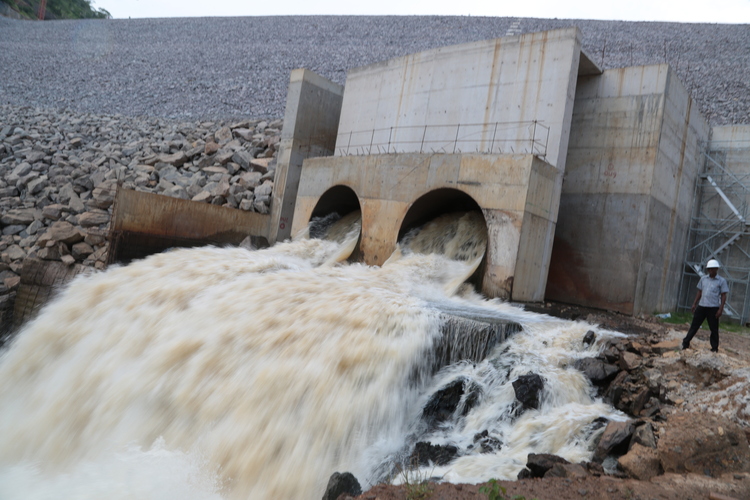
The Sunday Mail

Livingstone Marufu —
GOVERNMENT has provided US$95 million to guarantee the completion of Tokwe-Mukosi dam by year end, which is expected to transform Masvingo province into an industrial hub supporting key sectors such agriculture, tourism and energy.
The imposing man-made water body, with the capacity to handle 1,8 billion cubic meters of water, feed into the on-going drive to shift towards irrigation as opposed to relying on rain-fed agriculture in the drought-prone Masvingo province.
At the same time, there is scope for the generation of 15MW of hydroelectric power, which would be channelled to the national grid. The dam is over 96 percent complete and outstanding works would not be affected by rains as construction works are now taking place in the final layers of the wall.
Tokwe-Mukosi dam has already started receiving the rains that are currently falling in the country. Zimbabwe National Water Authority (Zinwa) chief executive Dr Jefter Sakupwanya told The Sunday Mail Business last week that the dam project will bring massive economic benefits to Masvingo province and the rest of the Lowveld area.
“The Ministry of Finance and Economic Development has availed US$95 million in three phases which are US$40 million, US$35 million and US$20 million to complete the dam project.
“All I can say is that the Finance and Economic Development Ministry has given us sufficient resources to ensure the completion of Tokwe Mukosi Dam and the contractor is currently on schedule to ensure that the dam impounds water by end of December 2016,” said Dr Sakupwanya.
Upon completion, Tokwe-Mukosi dam would become Zimbabwe’s largest inland lake with potential to irrigate an additional 25 000 hectares of land in the Lowveld, which represents almost 50 percent of the hacterage currently under irrigation in the area.
Due to the current drought, there are serious water shortages for irrigation in the Lowveld and the completion of Tokwe-Mukosi would ensure that irrigation water would be available even during drought years.
Dr Sakupwanya said the completion of Tokwe-Mukosi would help create employment for locals and those from beyond, both in the upstream and downstream industries of the sugar industry.
The dam, being built at the confluence of Tokwe and Mukosi rivers, will stimulate large-scale socio-economic development whose effects are poised to go beyond Masvingo province’s borders.
Tokwe-Mukosi is one and half times bigger than Lake Mutirikwi and can handle up to 1,8 billion cubic metres of water, which means it has the capacity to reconfigure several sectors such as agriculture, tourism and energy.
Water from the gigantic dam will help create a greenbelt in the vast Nuanetsi Ranch and Matibi 2 communal lands, turning Masvingo into a food self-sufficient region. Thousands of communal and smallholder farmers downstream will become major producers of cash crops such as sugar cane, cotton and maize, making the Lowveld the nerve centre of the country’s agriculture revolution.
Agronomists have already estimated that sugar production in the Lowveld would increase by at least 15 percent in a development that will see Zimbabwe angle towards achieving the one million tonnes of sugar per annum target.
Currently, the country is producing around 550 000 tonnes per year. The rise in production would consolidate Zimbabwe’s position as a major sugar producer in the region while at the same time earning the country millions of dollars.
With the Lowveld consolidating its position as an agricultural hub in Masvingo because of Tokwe-Mukosi dam, massive urbanisation is expected in the area with the likely effect of attracting investment in Masvingo, Chiredzi, Triangle, Chivi, Ngundu, Rutenga and Mwenezi.
Such investment will halt the great trek to neighbouring South Africa that is threatening to negate the developmental strides made since independence.
The concrete-faced, rock-filled Tokwe-Mukosi dam will also be a tourist attraction judging by its sheer size and architectural sophistry that blends well with the mountainous surroundings of Chivi, to create a once-in-a-life-time tourism spectacle whose impressions will astound many for generations to come.
Already, the Zimbabwe Bio-Energy, a consortium comprising a group of private investors and the Development Trust of Zimbabwe, responded by expressing readiness to set up the country’s third ethanol plant at the Nuanetsi Ranch, banking on sugar-cane produced using water from Tokwe-Mukosi dam.
The envisaged ethanol plant will be similar to the one at Chisumbanje in Manicaland and is projected to create 5000 direct jobs and benefit several communal farmers who will become cane outgrowers.
The construction of Tokwe-Mukosi dam has been dogged by financial problems since it started 17 years ago. Government is wholly funding the over US$255 million project.



